The odd thing about reviewing tech is that I am often evaluating—even resoundingly recommending—products I would never actually buy myself, because I am just not the type of person to drop a fat stack of bills on something unless I absolutely need it. And there's no getting around the fact that, short of winning a small fortune in the lottery, I cannot imagine a context in which I would spend $819 on the Boox Tab X C, a massive, 13.3-inch color notebook, even though I think it's a pretty outstanding device, as these things go.
Of course, lots of tech is pretty expensive, and lots of people are fine with investing in a device if they think it will meet their needs. And taking price out of the equation, I think the Tab X C will satisfy most anyone in the market for an e-ink notebook.
A cousin to the Boox Note Max
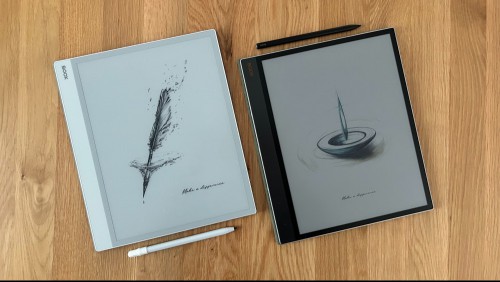
I've previously I reviewed the Note Max, another 13.3-inch digital notebook from Boox. From what I can determine, the Tab X C is virtually the same device under the hood. Both run on a 2.8GHz "octa-core" processor with 6GB of RAM and 128GB of internal storage. (Neither has an SD card slot, so that's all the storage you're going to get, but it's a pretty generous amount for a device built for documents). Both use on the same operating system (an open, modified version of Android 13), and can run the same suite of system apps and integrate with the Google Play store.
The downsides of color e-ink
The only difference, then, is quite literally the one you can see: The Tab X C has a color e-ink screen—the largest color e-ink screen you can get on a device of this type, in fact—as well as a temperature-adjustable front light. Those sound like big benefits, and they are, for the right user. But as my colleague Michelle Ehrhardt has previously pointed out, color e-ink isn't quite the miracle technology it sounds like.
Yes, the Tab X C maintains the positives of e-ink—it's easier on the eyes than a bright LCD or OLED screen, it's lower refresh rate extends the battery life, and the low-glare screen can be read in any lighting—while adding color. But the color doesn't exactly pop: the tech can reproduce 4,096 colors, compared to over a billion for an OLED screen, and what colors it can gin up appear muted and washed out. The resolution is also lacking; where the black-and-white content is presented at 300ppi, color content maxes out at 150ppi, so images tend to look grainy instead of crisp.
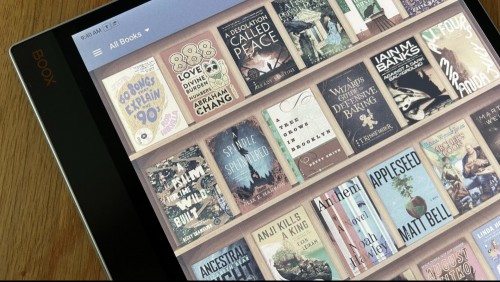
There's also the matter of clarity. Color e-ink devices actually use the same screens as black-and-white e-readers (in this case, the Carta 1300, the most up-to-date e-ink display), but there's a separate color layer sandwiched between the display and the glass that switches on when needed. Unfortunately, even when it isn't, it's still there—and you can always see it. The presence of that layer (the brand name for it is Kaleido 3) makes the screen appear significantly darker when the front light is switched off, and noticeably reduces the clarity of black-and-white text and images, and effect some have likened to reading through a screen door.
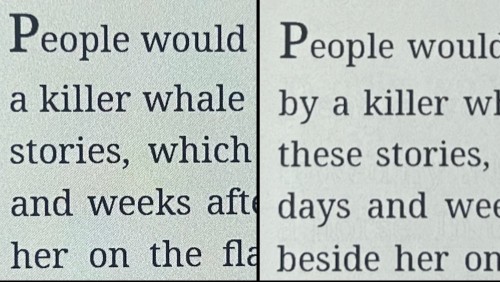
The front light is a plus (and potentially a minus)
While the effects are much less dramatic, the presence of a front light is also worth considering for a device built around stylus input. Without getting too into the weeds, one of the factors that makes writing on a screen feel more natural is reducing the distance between the outer surface on which you write and the inner display on which your writing actually appears. Adding a lighting layer increases that distance, creating a more notable separation; this can make it harder to make marks appear exactly where you want them to.
For the Tab X C, I'd call this a minor issue—but it's also why the Boox Note Max lacks a front light, as that device was engineered to reduce that distance as much as possible. On the other hand, a front light also means you can use the Tab X C in a dim room without having to switch on a light, which certainly isn't nothing.
A (weird) new writing experience
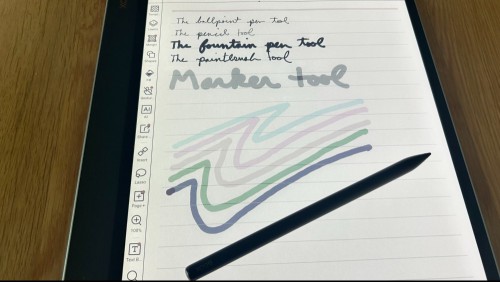
I've previously praised the experience of writing on the screen of the Boox Note Max and the smaller Boox Note Air 4C, each of which uses a Wacom EMR (electromagnetic resonance) pen that doesn't require charging or pairing. Taking notes and drawing on one of these tablets doesn't exactly feel like using a pen and paper, but it's a reasonably pleasurable tactile experience—I prefer the scratchier feel of the reMarkable Paper Pro and the Supernote Manta (reviews linked), each of which uses different tech. But it's also significantly better than the slippery, writing-on-glass feel of the other writeable Boox devices I've reviewed, the Go 7 and Go Color 7, which must be paired with a USI 2.0 stylus.
Unfortunately (for me at least), despite the premium price tag, writing on the Tab X C feels closer to the Go 7 devices, with one weird touch. First, instead of EMR, the Tab X C also uses a USI stylus that must be paired with the tablet, though the process is seamless—it attaches to the side of the device via a magnet for pairing and charging. But like those entry-level writeable devices, the feel of moving the tip of the stylus across the screen of the Tab X C is too slick for my liking; it's closer to the "writing on glass" feel of an iPad and Apple Pencil than the Note Max or Note Air 4C.
Chatter among the Boox faithfuls on Reddit suggests a few possible reasons Boox didn't use EMR for the Tab X C, from wanting to make the device thinner to needless "innovation." There's one that I find most plausible, however: All e-ink screens are made by the same company (it's called, uh, E Ink), and its quite possible that it just doesn't produce a 13.3-inch display that offers both a color layer and an EMR layer.
A divisive solution
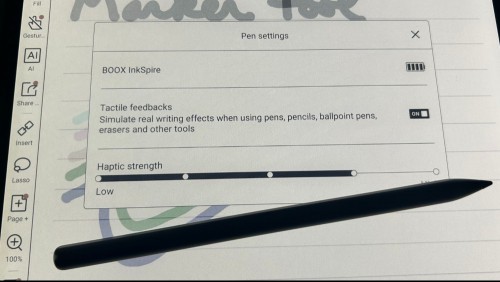
Regardless of the reason, the Tab X C's "InkSpire" stylus just isn't as nice to write with. But (and here's where the "weird" part comes in), Boox has attempted to solve for that by building haptic feedback into the pen itself. It's a little hard to describe, but basically, when you write onto the screen, the stylus will "buzz" a little bit in an attempt to convince you you're actually feeling more resistance than you are. It doesn't really feel anything like actual friction between pen and paper, but it feels like...something, anyway.
The first time I tried it I was reminded of those vibrating hand buzzers sold in joke shops, but you can adjust the intensity in the settings to make it less jarring (or turn it off altogether), and the performance has been tweaked and improved over the course of a few system updates. As of this writing, I'd describe the effect as fairly subtle, though the amount of feedback varies based on the virtual writing implement you choose—the pencil offers more vibration than the ballpoint pen, whereas the marker and paintbrush provide almost none.
Anecdotal evidence (again from the Boox subreddit) suggests that while some people find this a decent way to improve the writing experience—and a few even seem to outright prefer it—the majority seems to think the EMR writing experience is better. I'd agree, though the difference isn't so drastic for me that I'd, er, write the device off entirely.
A full-fledged Android tablet, sort of
With that technical nattering out of the way, what is this device good for? While it has access to the Google Play store and can thus run basically any app you want (including full-motion games and streaming apps like Netflix), it's not really an e-ink replacement for your iPad. Those video apps aren't going to be very pleasurable to use—even when you adjust the variable refresh rate to the fastest speed, you're still going to see a ton of artifacting and motion blur. (That said, my kid has more than once attempted to play Roblox on the Bigme B751C seven-inch reader I've been letting him use, so...if you're desperate, I guess.)
This is actually a device for disconnecting from some of the distractions of the more vibrant screens that surround you. Mixed writing experience aside, it's great for taking and organizing your notes and doing research, especially if you work with a lot of books and PDFs you want to annotate. The native reading app, called NeoReader, allows you to write directly into a variety of file types and export them with your notes intact. The Notes app offers a number of options for organizing your work, from syncing with cloud services to letting you link to or append other notes and files.
App store compatibility also means you can use it to run all of your usual productivity apps, from Google Docs and Google Calendar to OneNote.
A fantastic oversized e-reader
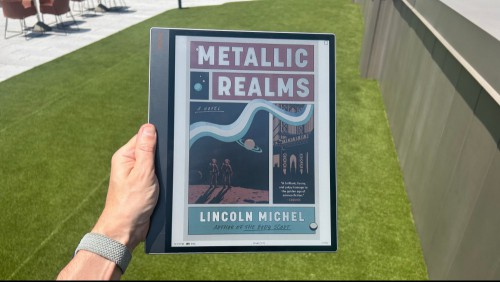
If you want a large screen for reading your books, comics, and manga, the Tab X C will also serve you very well, provided you have a flat surface to lay it on (at 625g, it's not exactly feather light). The aforementioned NeoReader app is highly customizable, allowing you to add your own fonts and fine tune your display settings; it also has text-to-speech capabilities built in. If you prefer, you can of course install any reading app from the app store as well, which means you can read your entire library of e-books from Amazon, Barnes & Noble, or any other source.
I particularly love these massive Boox devices for reading manga and, for the Tab X C, color comics. If you've got a large digital collection (or subscribe to an on-demand comics app like Marvel Unlimited or Shonen Jump), it can be an ideal way to read without the distractions and eye fatigue of a glossy tablet screen.
The problem with ghosting
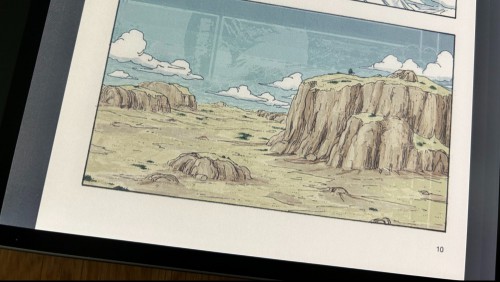
There's one more drawback of color e-ink (and e-ink in general) that's worth noting here: ghosting. This is the after image left from whatever was on the screen previously after you "turn the page" (or open a different app). All Boox devices have variable refresh rates that can be set on a per-app basis, but even on the "best" settings, the Tab X C can show a significant amount of ghosting when you're viewing color content like comics.
You can eliminate ghosting by performing a manual page refresh (for which you can set a simple screen gesture) but it's kind of annoying to do this with every page turn. The severity of the ghosting will vary based on the type of material you're reading, the app you're using, and your settings (maybe you're willing to endure more after-images in pursuit of speedier page turns, for example), but it's definitely a major drawback you shold be aware of before investing in a device this expensive.
The illusion of good battery life
One advantage of e-ink screens is that they use a lot less power than brightly lit OLED or LCD screens, but for the Tab X C, this is negated somewhat by the need to constantly have the backlight on to account for the darker screen. Also, if you are using apps that require the screen to refresh more often (whether you're reading full-color comics or browsing the internet), you'll drain the battery even faster.
While you probably won't need to charge the Tab X C every day as you would an iPad, you'll probably need to charge it every couple of days—a far cry from the "goes a month on a single charge" boasts of single-purpose e-ink devices like a Kindle Paperwhite.
A device aimed at a niche of a niche market
You may have noticed I don't really have much negative to say about the Tab X C outside of the universal downsides of color e-ink and the potentially divisive writing experience. All in all, this really is an excellent flagship digital notebook, arguably improving upon the Boox Note Max with the addition of color and a front light.
But it also costs $819—plus tax. And that's a lot of money for what is already a specialized device, and nearly $200 more than the Note Max, which I already thought was so expensive that it didn't make sense for most people when a significantly cheaper iPad would serve them better.
But if you're already a part of the niche market for e-ink tablets, it starts to make more sense. Yes, I think most people should still opt for the $300 cheaper Boox Note Air 4C. But if you want a really, really big color screen, well, they literally don't come any bigger.
Covering e-readers, social media, entertainment, and more.
